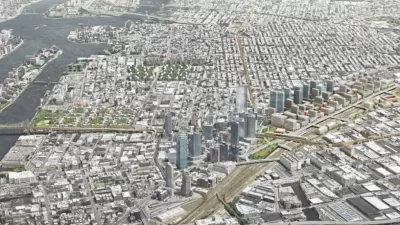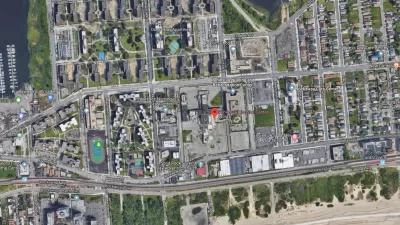It's known as the Iron Triangle, though some call the sewerless 13-block collection of auto junkyards just east of Shea Stadium an eyesore and disgrace. A controversial application of eminent domain is at the heart of the $3 billion makeover plan.
From NYT, July 8, 2007:
It is "an astonishingly ramshackle industrial shantytown, something out of "Mad Max," bereft of most city services. The unlit streets are blocked by 40-foot-long puddles of standing water, filling truck-length potholes that traffic must creep around. Since there are no sidewalks, pedestrians share the street with cars; nor are there sewer lines for toilets, and most of the buildings are jerry-rigged structures of corrugated aluminum."
From Queens Chronicle:
"In an agonizing vote that took 5 1/2 hours to reach, (Queens) Community Board 7 members voted 20-15 (on July 1) to approve the city's controversial Willets Point development plan.
The city wants to redevelop the 60-acre area now occupied by car junkyards and businesses into a mixed-use area including 5,500 housing units... There are no sewers or sidewalks there now, continuing to draw the ire of business owners, who say that if the city put in those improvements, the area would evolve on its own.
Seventy speakers were scheduled to give their opinion on the project. They were equally divided among those who supported the plan - union leaders and environmentalists - and those who opposed it - workers and owners plus proponents of more affordable housing.
The issue of the city using eminent domain to take properties did not sit well with many community board members and certainly not with the business owners. Although the city has said it is working in good faith to find new locations for the 250 businesses in Willets Point, so far only two landowners have agreed to sell."
"Without a complete cleanup of the soils beneath Willets Point, all our efforts at cleaning up the surrounding waterways will come to naught," said one advocate for redevelopment.
From NYT (May 29, 2005):
The Iron Triangle "was supposed to be part of Flushing Meadows, home of the Mets and the U.S. Open tennis tournament and the site of two world's fairs. But because of the machinations of the master builder Robert Moses and the oratorical skills of a young lawyer named Mario M. Cuomo, a strategically located part of Queens one-tenth the size of Central Park became a junkyard, a veritable wall of concrete, oil and scrap metal that prevents development along the Flushing waterfront.
On a clear day, the stretch of car repair shops, scrap metal depots and waste treatment plants resembles nothing so much as a scene from "The Road Warrior." The thoroughfares are blistered with holes like the surface of the moon, and the wind churns up clouds of dust that blow through 70 acres of scrap metal, mounds of contaminated earth and abandoned cars of every description."
FULL STORY: C.B. 7 Approves Willets Pt. Plan

Maui's Vacation Rental Debate Turns Ugly
Verbal attacks, misinformation campaigns and fistfights plague a high-stakes debate to convert thousands of vacation rentals into long-term housing.

Planetizen Federal Action Tracker
A weekly monitor of how Trump’s orders and actions are impacting planners and planning in America.

In Urban Planning, AI Prompting Could be the New Design Thinking
Creativity has long been key to great urban design. What if we see AI as our new creative partner?

Portland Raises Parking Fees to Pay for Street Maintenance
The city is struggling to bridge a massive budget gap at the Bureau of Transportation, which largely depleted its reserves during the Civd-19 pandemic.

Spokane Mayor Introduces Housing Reforms Package
Mayor Lisa Brown’s proposals include deferring or waiving some development fees to encourage more affordable housing development.

Houston Mayor Kills Another Bike Lane
The mayor rejected a proposed bike lane in the Montrose district in keeping with his pledge to maintain car lanes.
Urban Design for Planners 1: Software Tools
This six-course series explores essential urban design concepts using open source software and equips planners with the tools they need to participate fully in the urban design process.
Planning for Universal Design
Learn the tools for implementing Universal Design in planning regulations.
Gallatin County Department of Planning & Community Development
Heyer Gruel & Associates PA
JM Goldson LLC
City of Camden Redevelopment Agency
City of Astoria
Transportation Research & Education Center (TREC) at Portland State University
Jefferson Parish Government
Camden Redevelopment Agency
City of Claremont




























